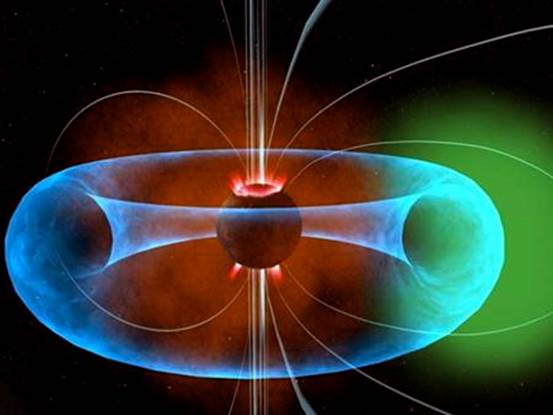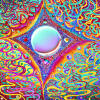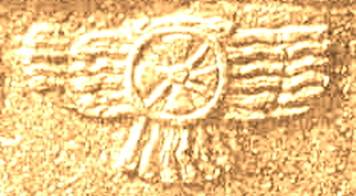
Universal Cosmic God-Laws
Any true science would reflect the Cosmic Laws that bring the universe into
being — God-Laws. There would naturally be a correlation between
metaphysical laws that are the eternal substratum of the manifested universe
and the physics of the external manifested realms. Theoretically, if you
know the basic God-Laws, then the various applications of other sciences
will fit harmoniously into them. Knowing the one substratum leads you to
understand them all, at least in principle.
The metaphysical principles that govern our own inner reality, the mechanics
of enlightenment, our spirit or astral body with its seven chakras, the
three gunas, the mysteries of five-sense perception, and our eternal
interconnectedness to the All, will resonate in harmony with the physical
sciences to the degree that theses sciences express the Universal Cosmic
order, the Laws of God. Any true real science must be founded upon and in
complete harmony with primordial metaphysics.

Infinitesimal Whirls
Bruce Cathie quotes the genius inventor Nicola Tesla from an unpublished
article: "Long ago he (man) recognized that all perceptible matter comes
from a primary substance of a tenuity [a rarified state] beyond conception,
filling all space, the Akasha or Luminiferous Ether, which is acted upon by
the life giving
prana
or creative force, calling into existence, in never ending cycles, all
things and phenomena. The primary substance, thrown into
Infinitesimal Whirls
of prodigious velocity, becomes gross matter; the Force subsiding, the
motion ceases and matter disappears, reverting to the primary substance."
This statement from Tesla sounds as if it has been taken verbatim from a
Sanskrit text! Cathie himself says, "Matter is nothing more than a complex
matrix of wave-forms locked together by harmonic resonance." ['The Energy
Grid']
Rene Guenon has written extensively about the disconnect in modern times
between the primordial metaphysical principles and what he terms the profane
sciences: "...most of these sciences, even insofar as they still correspond
to some reality, represent no more than simple debased residues of some of
the ancient traditional sciences."
Guenon explains that numbers have lost their real meaning. He states that
our contemporaries are ignorant of what number truly is and understand
number only its strictly quantitative sense, reducing number to "calculation
in the narrowest sense of the word, that is, to a mere collection of more or
less artificial procedures, which are in short only valuable with respect to
practical applications to which they give rise." According to Guenon, only
geometric form can be legitimately considered to constitute the true body of
a number. This is in "accordance with the fact that all 'embodiment'
necessarily implies a 'spatialization'." The science that is exclusively
quantitative distances itself further and further from reality.

The Inter-Connected Substratum
The Universal Cosmic God-Laws are the substratum of the manifested realms.
In others words, the appearance of the solidity of material forms in varying
densities rests upon a metaphysics that reflect the eternal harmonics found
in primordial God-Laws. This explains why so many theoretical sciences can
be seen in the Rig Veda, and also why there are so many varying
translations. The Rig Veda was composed in the older Vedic Sanskrit, the
meaning of which scholars cannot agree on. I have concluded that I am able
to discern the mechanics of electricity, electromagnetism, plasma physics,
and now magnetic fusion technology — right along with the inner esoteric
ancient Wisdom-Knowledge in these ancient hymns because of eternal harmonic
resonant correspondences between the inner 'invisible to the five senses'
realms and external apparent manifestations.

Pratibimbavâdah: The Mirror of Consciousness
The outer realms are a reflection of the eternal Law. Therefore the more
closely the outer material solidity expresses, corresponds and harmonically
resonates with the inner Universal Cosmic God-Law, the more perfect the
technology will be — meaning the technology will be elegant, efficient, not
wasteful or producing toxic side effects.
The concept of the outer manifested universe reflecting the inner substratum
is found in Kashmir Shaivism's theory PRATIBIMBAVÂDAH. The great philosopher
saint Swami Lakshmanjoo explains the 'Theory of Reflection' -
Pratibimbavâdah thus:
In the ordinary worldly course, sound is reflected outwardly in Ether and
inwardly in the ear, touch comes through the air to the skin, external forms
are perceived in the eye, taste in the tongue, smell in the nose. These are
all reflections of the external that are received and perceived by the five
senses — just like a reflection in a mirror. These reflections [pratibimba]
take place individually, but are observed at once. We rarely consider one
perception coming to our senses without another. Thus it is the awareness
found in consciousness - not in the organs - that allows us to connect and
interact with the external objects of the senses.

God's Free Will
"The universe, therefore, is reflected in the mirror of consciousness, not
in the organs nor in the five gross elements. ...the real reflector is
consciousness. In consciousness, however, you see only the reflected thing
and not the object that is reflected. That which is reflected (bimba) is in
fact
svântantrya
[God's free will 'play'] in God Consciousness. ...There can be nothing
outside the mirror of God Consciousness. ...Svântantrya is the mirror.
Svântantrya, the absolutely independent will of God, is the cause of this
reflection."
The metaphysical idea that the appearance of the universe is a reflection in
the mirror of God Consciousness makes the spherical layers of meaning the
ancient Vedic Sanskrit perfectly reasonable. Each word contains many
possible meanings that reflect various states of consciousness — from the
most mystical, sacred geometry, Sanâtana Dharma to electricity,
electromagnetism, astrophysics, plasma physics, and magnetic fusion
technology. Linear thinking is a limitation we need to leave for a more
complete inclusive holistic thinking in harmony with Universal Cosmic
God-Laws.

The verses in hymn I.164 by the Rishi Dîghatamâ are a goldmine of layered
meanings from the most esoteric spiritual to space era science. For example
we find the theory of Pratibimbavâdah in the Cosmic Wheel of Time, which is
said to have two existences, to be in pairs:
Rig Veda I.164.11
The Wheel of 12 spokes
[divisions of the heavens/zodiac]
that does not decay,
revolves again and again,
repeatedly goes round the heavens,
the Cosmic order like the sons of fire [Agni]
that reside in pairs here [in this wheel]
as the seven hundred and twenty
[2 x 360 degrees of the external wheel mirrored in the internal]

A Torus in Rig Veda I.164.2
One [eko] chariot [aerial ship - ratham] carries, bears along [vahati],
allied, connected [yuñjanti] to the wheel [cakra - torus] having three
axle-holes [trinâbhi - the axis of three geometric toroidal forms],
[which is fueled by] the named seven powers [of the gaseous state of plasma
- vâyu]
that generate velocity [ashvo - horse power],
that is un-decaying, unlimited [a source of perpetual energy].
All the worlds [bhuvana] stand and remain supported in these wheels [the
torus geometric form].
The above verse I.164.2 contains the Sanskrit words
trinâbhi-cakra
defined by some scholars as three axle-holes. The verse is perplexing indeed
and when I read the statement by one Indian scholar that,
"In fact no commentator is helpful in correctly understanding the
meaning of trinâbhi-cakra - three axle-holes."
— I became more curious.
The Sanskrit root √nabh is defined as the navel, a navel-like cavity, the
nave of a wheel; nâbhi means 'to burst asunder or into a hole'. The
eka-cakram 'one wheeled' source of power the
Rishi Dîrgatamâ was writing about was a torus.

I.164.3
In this aerial ship [ratham] stand
the seven wheels of seven velocities [ashvah]
[that] carry well, bear along [as] one velocity,
[suspended in space] over the seven sisters [Pleiades];
in which [is] placed the seven names
[cosmic powers of] the lord of the rays [Agni].
Dr. Tulsi Ram says verse I.164.3 is a "highly mystical, symbolic and
scientific mantra; astronomy, cosmology, physics and mechanics. Still the
meaning would remain open."
Galactic Cosmic Rays: Move in spirals owning to their high speeds, they have
large gyro-radii (gyral = moving in a circle or spiral; radius = the
straight line from the center of a circle or sphere to the circumference;
any set of lines, rods,
spokes,
diverging from a point.)
Galactic Cosmic Rays: propagate from the heliopause towards the inner
heliosphere and are hindered during solar maximum due to increasing solar
activity. Like solar particles, galactic cosmic rays travel field parallel,
they can drift in the large-scale structures of the field, and they are
scattered at the magnetic field irregularities. In addition, the particle in
galactic cosmic rays also experience convection and adiabatic (involving or
allowing neither gain nor loss of heat) deceleration, and they are blocked
and reflected at transient inhomogeneities such as magnetic clouds and
shocks.
Galactic Cosmic Rays: Their drifts can be several times
the solar wind speed; thus, drifts can by far exceed convection with the
solar wind.
[Space Physics]
This says to me that the 'Mother' in the heart of any galaxy can overpower
the ray emissions any star whenever she needs to 'feed' her planets — by
emitting highly energetic cosmic ray particles and an intense outpouring of
electromagnetic emissions of radio waves, infrared rays, visible light,
ultraviolet rays, X-rays, and gamma rays [P.A. La Violette]. The invisible
interactions, gyrations of plasma and particles colliding in spirals in
space are intricate and intensely complex. No wonder a supercomputer is
required for their mathematics!

Approaching the Sacred
There is also, I confess, a marvelous sense of approaching the sacred when I
am working with these verses. I completely understand why they were
protected, kept intact throughout the centuries, and held in such high
esteem. It is a shame that a few western scholars have seemingly
misunderstood the deeper meaning hidden within their spherical layers. These
mantras truly express the ineffable, something so highly subtle that flows
in the consciousness of the Rig Veda, and one can't quite ever put into
words. It is as if I am reaching back into time, into the previous cycles of
time, when perhaps linear thought was not the norm — but rather beings
communicated multiple layers of meaning simultaneously. One might say the
Rishis 'download' multiple levels of information in one word.
My way of finding the meaning is to compare the interpretations in five
translations with the definitions I find in Sanskrit Dictionaries and Vedic
Etymology, and then intuit my own understanding. It is a meticulous puzzle,
a slow process, time consuming, and frankly sometimes a bit tedious. I am
not a scholar. However I continue my pursuit, for the rewards are great. My
sense of connection with the Rishis is reward in itself — and there is the
subtle elusive state of being more at Home with their thoughts than with my
own times, which often bewilder me. I feel blessed to be able to study the
Rig Veda. I hope my humble renderings communicate something of this joy I
experience in my journey into the sacred Rig Veda.

Resources:
The verse translation-renderings are mine, but based on the translations
of Indian scholars and Sanskrit dictionaries. I touch their feet in respect
and gratitude.
RIG VEDA SAMHITA: Mandala - 3, (Text in Devanagari, Translation and Notes),
by R.L. Kashyap; Saksi, Sri Aurobindo Kapali Sastry Institute of Vedic
Culture, Bangalore, India, 2007.
Rig Vedic Suktas, Asya Vamiya Suktam, A Contemplative Study by Swami
Amritananda; Sri Ramakrishna Math, Mylapore, Chennai, India, 2003.
RGVEDA for the Layman, A Critical Survey of One Hundred Hymns of the
Rigveda, with Samhita-patha, Pada-patha and word meaning and English
translation, by Shyam Ghosh; Munishiram Manoharlal Publishers Pvt. Ltd., New
Delhi, 2002, Nandi, Indira.
RIG VEDA, Complete in 12 Volumes, Mantras in Sanskrit with English
Translation and Transliteration; Translated by Swami Satya Prakash Saraswati
and Satyakam Vidyalankar; DAV Publication Division, Delhi India, 2011.
Modern English Translation of The Rig Veda Samhita, 4 Volumes, by Prasanna
Chandra Gautum; Bharatiya Vidya Bhavan, Mumbai, 2014.
Rig Veda, Four Volumes, With Original Sanskrit Text, Transliteration & Lucid
English Translation in the Tradition of Yaska & Dayananda; English
Translation by Dr. Tulsi Ram, M.A., PhD. (London); Arsh Sahitya Prachar
Trust, Delhi India, 2013.
VISVAMITRA in Vedic & Post Vedic Literature, Edited by B.B. Chaubey;
Vishveshvaranand Vishva Bandhu Institute of Sanskrit & Indological Studies,
Panjab University, Hoshiarpur, 1987.
A Study of Deities of the RIG VEDA, With the help of Science, by S.S. Gupta;
Abhinav Publications, New Delhi, 2006.
Vedic Physics, Scientific Origin of Hinduism, by Raja Ram Mohan Roy, Ph.D.,
foreword by Professor Subhash Kak; Golden Egg Publishing, Toronto, 1999.
VEDIC PHYSICS, Towards Unification of Quantum Mechanics & General
Relativity, by Keshav Dev Verma; Motilal Banarsidass Publishers, Delhi,
1991, 2008.
Space Physics, An Introduction to Plasma and Particles in the Heliosphere
and the Magnetospheres, by Dr. May-Britt Kallenrode; Springer-Verlag, Berlin
Heidelberg, 2010.
Cosmic Plasma, by Hannes Alfven; D. Reidel Publishing Company, Dordrecht
The Energy Grid, Harmonic 695, The Pulse of the Universe, by Bruce L.
Cathie; Adventure Unlimited Press, Illinois, 1990, 1997.
The Metaphysical Principles of the Infinitesimal Calculus, by Rene Guenon,
1946; translated by Michael Allen & Henry D. Fohr; Sophia Perennis,
Hillsdale, NY, 2003, 2004.
Kashmir Shaivism, The Secret Supreme, Revealed by Swami Lakshmanjoo, edited
by John Hughes; Universal Shaiva Fellowship, 2003.
VEDIC ETYMOLOGY, A Critical evaluation of the Science of Etymology as found
in Vedic Literature; by Prof. Fatah Singh, M.A., B.T., D.Litt.; Chaukhamba
Surbharti Prakashan, Varanasi, 1952, 2008.
THE ROOTS, VERB-FORMS and PRIMARY DERIVATIVES of the SANSKRIT LANGUAGE, (A
Supplement to His Sanskrit Grammar, 1879), by William Dwight Whitney;
Motilal Banarsidass Publishers Pvt. Ltd, Delhi, 1963 - 2006.
A Concise Dictionary of Indian Philosophy, Sanskrit Terms Defined in
English, John Grimes; Indica Books, 2009.
Sanskrit-English Dictionary, M. Monier-Williams; Two volumes, Recomposed and
improved edition; Indica Books and Parimal Publications, New Delhi, 2008.
|
Questions
or comments about articles on this site: |
Copyright© V. Susan Ferguson |
Technical questions or
comments about the site: |
|
|